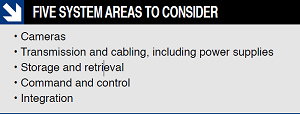Organizations have experienced increasing demand for surveillance technology, to protect people as well as private and public assets. Mark Wilson, VP of Marketing for Infinova, explores how recent events, from boarding airlines to protecting embassies, highlight the growing needs for security.
Organizations have experienced increasing demand for surveillance technology, to protect people as well as private and public assets. Mark Wilson, VP of Marketing for Infinova, explores how recent events, from boarding airlines to protecting embassies, highlight the growing needs for security.
One of the most challenging dilemmas facing security managers is when and how to take the leap from analog to an IP video system. They want to jump to IP surveillance but in a cost-managed way that extends the life of existing equipment. For most sites, this migration will take place gradually. During the process, analog and IP solutions will have to coexist.
Cameras
A key consideration for security professionals is whether the existing cameras or new IP ones will provide the image quality needed to achieve the functional requirements of the system. Each application has different requirements; some users require the ability to see and track suspects in changing lighting conditions, while others simply need to see that a corridor is clear.
In many migration plans, specific locations of greater vulne r abi l i ty or image detail requirements are ideal places for network cameras, including megapixel and high definition models. One needs to ask if higher resolution cameras can help at
each location.
As part of a coexistence plan, analogto- digital encoders at the camera end can transform images from an analog camera to digital transmission and storage. The analog control room equipment gets scrapped, but the new IP control room equipment controls the already-installed analog cameras.
Another approach holds down the budget at the beginning. The existing analog equipment, including cameras, control room, video wall and cabling remains untouched. VMS software, integrated with the present keyboard, sits on top of the system to manage the new IP equipment and the already-installed analog system.
Transmission Choices
Coaxial, shielded twisted-pair and unshielded twisted pair-cable, fiber optics and a variety of wireless approaches carry most security video. The differences and business advantages of the various transmission schemes are in the cost of installation and cost of maintenance. A question to ask is whether the new network
cameras will eliminate long-distance analog cabling.
One strategy to handle both analog and digital networks is to transmit all signals over a single fiber optic cable that is secure and immune to electrical or environ- mental interference. Installation is simplified by eliminating the need for multiple fibers, transmitters and receivers. Not to be forgotten are power supplies. Following a coexistence plan, power supplies that are multitap, addressable and programmable have advantages.
Other considerations include the increased bandwidth impact on the enterprise's network. This is a tricky assignment and IT can help. Will newer types of compression, decompression or codec, such as H.264, reduce bandwidth traffic load but at a cost of more storage and command center processing? Can the budget afford the increased transmission and storage associated with megapixel cameras?
 Storage and Retrieval Challenges
Storage and Retrieval Challenges
Most security organizations already have DVRs for storage and retrieval. However, storage solutions have their own challenges, thanks to myriad features and benefits. These range from common specifications to helpful elements, such as intelligent PTZ control with preset positions, and e-mail or SMS message notification upon motion detection or event alerts.
At the camera edge, security managers are also deploying SD storage cards. This is important in applications where loss of connection to the rest of the system could lead to lost images.
Regardless, there are several questions to consider before selecting one mode or another on the pathway to IP:
● If the video is being monitored from a remote location, will one get exception reporting?
● Do files ever need to be shared with other departments, including law enforcement, in real time?
● How much does one need to record and how long does one need to keep those recordings?
Command and Control Options
There is a great deal to consider with command and control. Traditional matrix switching and joysticks are workhorses, but in a fast-approaching software world, a solid next step is the consideration of networked video matrix switchers.
Traditionally, in the leap from analog to digital video, organizations convert analog signals to digital signals by buying and installing rack encoders for their bank of analog cameras. They replace the analog control room equipment with new IP control room equipment. This can be expensive at the front end.
Some believe that a better way is to create a coexistent system. In this scheme, the system keyboards connect to a VMS, not the matrix switchers. The analog side of the coexisting system stays untouched.
 Nothing is added to it. However, since the VMS sits on top of the system, operators use their traditional keyboard commands to manage both the analog and digital solutions.
Nothing is added to it. However, since the VMS sits on top of the system, operators use their traditional keyboard commands to manage both the analog and digital solutions.
That's because the VMS interfaces with both the system's analog matrix switchers as well as the network cameras. As a result, on the combined video wall, the analog and IP solutions coexist but are still separate. Transparent to the operator, with no mouse needed, the system sends network camera images to the digital monitors and analog camera signals to the analog monitors. With this coexistent solution, agencies can use an IP solution simply by adding network cameras, digital monitors and VMS.
Integration
True security system integration is a goal of most security operations. Beyond relays and interfaces, seamless integration of security video with electronic access control, intrusion, perimeter and identification systems is a beneficial end-point of any operation and one made simpler through IP.
No matter the speed of migration, a solid plan is one in which both analog and network cameras can coexist. Such coexistence increases security's overall situational and domain awareness, as well as improving its operational effectiveness. A hybrid solution provides a growth plan that extends the life of existing equipment, is affordable and is easy to manage.